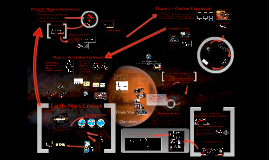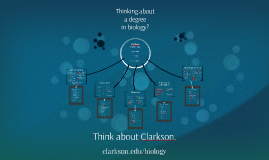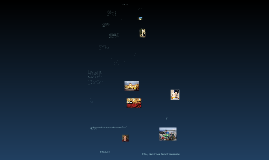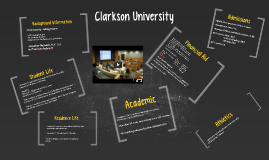Clarkson University RASCAL 2011
Transcript: Conclusion Mars-Plan entirely different from the Apollo Mission No rush for a first manned mission just to go there Timeline established for a reliable, fully reusable, and affordable Earth-Mars transportation system Related to a the manned Mars development Master Plan Expandable and sustainable system with ISRU With this philosophy in mind, reusability, affordability, and sustainability, we can resume space activities to guarantee mankind future in space, to Mars and beyond! Thank You Questions Robotic arm & tether connection Boosters for artificial gravity Heavy shields Medical care facility Martian Outpost Earth to Leo Business Activities Settlement Assembly BM NM1-NM2 HM1 Terrestial Feeder (TF) Martian Feeder (MF) RASC-AL 2011 Theme Design proposal Systems, equipment, methods and procedures Technology –enabled manned mission to Mars Retriever: a specialized vehicle for asteroid capture 20 individuals together with related work facilities Expanded Cruiser 2004 FH 30 m diameter 2.8e7 Kg 43,000km from Earth surface More personnel Initial cruiser transformed into a travelling hotel Cruiser expansion, hundred of passengers Expansion by addition of specialized modules Thrust Required Mission 3 – Return to Earth RASC-AL 2011 Technology, enabled human Mars mission Yvy Pitâ (‘eevee peetah’ – Red World in Guarani, one of Uruguay’s native languages Activities and Facilites Middle Level Lower Level Advisors Pier Marzocca Giorgio Gaviraghi expanded cruiser middle level Retriever: A basket-like vehicle to deflect asteroid Two thrust vectoring engines Capture NEO, slowly deflection to a desired trajectory with small rotations. Mission 1 – Connection Nodes NM1 (Earth Side) & NM2 (Mars side) NM1 and NM2 weight 5 Tons BM Clarkson University Anas Achouri Julian Corpus Jonathan Hladchuk Benjamin Hunold Steve Mbazo Giulio Soliani Casey Stockbridge Megan Williams Phase 1 –Earth-Mars Transportation System Operational upper level Asteroid Retrieving Mission Cruiser Settlement Rent space and facilities Transport and process Martian materials Summary of Business Activities 1- Sustainability, manufacturing all life support needs, food, fuel, etc. 2- Overhaul & maintenance of the vehicle 3- Supply room, food, and lodging for pax 4- Supply work space for its crew and pax 5- Assemble retriever vehicles 6- Fly retriever missions for asteroid and comet capture and ISRU 7- Assemble and support trans-mars space missions 8- Martian materials & manufactured products transported to Earth and vice versa Risk free human and robotic Martian activities Interplanetary transportation system In-situ resources utilization Promote Martian development Space base for trans-mars missions Space settlement with sustainable activities Business Activites Cruiser Expansion Range of radii needed to produce artificial gravity on the cruiser from Earth to Mars and corresponding angular velocities deflected astroid Expanded Cruiser Schedule Buisiness Activites Using Hohmann transfer orbit to move 2004FH to a circular orbit of radius 30e6m around Earth, thrust required is 1.06e9N Cruiser will return to Earth New crew will use HM in the cruiser, TF for return mission, MF to set up the Martian outpost Profit Plan martian feeder-lander Crew safety, Reliable and sustainable missions Maximum in-situ resources Safe, self sufficient and sustainable local human habitat. Martian Cycle Earth –Mars two-way mission Transfer time approximately 26 months The asteroid is deflected to the desired orbit Many small NEOs to be inserted in Earth-Moon or Earth-Mars cyclical orbits, Properly equipped will act as low cost space transportation system Design features (minimize mission risks) STEP 1- Earth-to-ISS using existing expendable booster technology vehicles. Reusable TSTO or SSTO STEP 2- Space tug ISS-to-Cruiser, container system loaded and launched to rendezvous & connect to the incoming cruiser Entirely reusable, maintained and refurbished in space Modular Vehicle traveling between Earth and Mars Basic Module (BM): Communications Navigation Power generation Fuel tanks Engines Storage area Robotic arm (external) BM weight 20 Tons Design Requirements Requirements Phase 2 – Expanded Cruiser Business Activities Schedule Expanded Cruiser Mission 2 – First Manned Mission Terrestrial Feeder (TF) Estimated Phase Cost 500m total diameter Population 1000 Modular Eco-cell system - 20m height - 200m2 ground floor - capacity 10 people Mars surface mission Up to 5 launches , 125 m (LEO) payload launch vehicle Feeder-cruiser system entirely reusable 3 main components: - Cruiser - Terrestrial Feeder - Martian feeder 4 crew members Cruiser facilities: fully equipped habitat, life support systems (air, water, fuel), waste treatment, recycling equipment, food production Habitat Module (HM) weight 20 Tons Earth-Mars Cruiser Disease-free environment Active health monitor and control system Nanochip probe Monitoring system in Health Care Center (HCC) Computer body models Terrestrial Health Control

















